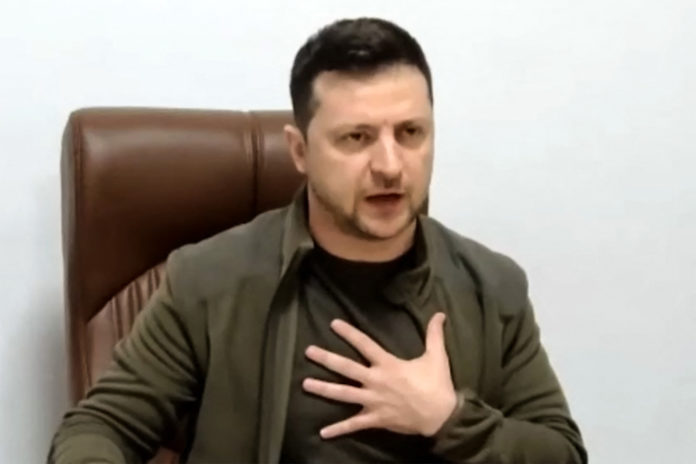
Ukrainian President Volodymyr Zelensky warned Tuesday that the Kremlin is waging an “overt gas war” in an effort to disrupt Europe’s united opposition to Putin’s invasion. His comments came as the Russian state-owned energy supplier Gazprom announced a drastic reduction in gas deliveries to Europe, citing technical issues with a turbine. The cut means that around 20 percent less gas will flow to Germany via the Nord Stream pipeline. The EU disputed the energy company’s account of the reduction, which came after supplies had already dropped to 40 percent last month.
“All this is done by Russia deliberately to make it as difficult as possible for Europeans to prepare for winter,” Zelensky said. “This is an overt gas war that Russia is waging against a united Europe—this is exactly how it should be perceived. And they don’t care what will happen to the people, how they will suffer—from hunger due to the blocking of ports or from winter cold and poverty.” Read more at The National.












“Zelensky Says Russia Is Waging an ‘Overt Gas War’ Against Europe.”
One Ukrainian volunteer fighter reportedly agreed with the Ukrainian President’s assertion about Russia’s ‘Overt Gas War’ :
“Zelensky is correct,” said the Ukrainian volunteer fighter, “because I can tell you one thing: ‘I’m definitely running out of gas and energy!’ And I’m sure the Russian soldiers are also running out of gas. Which is why gas, and ALL sources of energy, are at a premium these days, because no army in the world can sustain itself without a vast source of כוחות and energy!”
Stop lying Z. Tu eres bebe.
As Rabbeinu Trump said, Putin is SMART. Evil and shrewd, but cunning and smart
He wants total sanctions against Russia including no purchase of energy from Russia while complaining if Russia doesn’t sell to Europe. Which is it?
The overt gas war already belongs to cholent consumers across the world.
Natural gas is a fossil fuel. Like other fossil fuels such as coal and oil, natural gas forms from the plants, animals, and microorganisms that lived millions of years ago.
There are several different theories to explain how fossil fuels are formed. The most prevalent theory is that they form underground, under intense conditions. As plants, animals, and microorganisms decompose, they are gradually covered by layers of soil, sediment, and sometimes rock. Over millions of years, the organic matter is compressed. As the organic matter moves deeper into Earth’s crust, it encounters higher and higher temperatures.
The combination of compression and high temperature causes the carbon bonds in the organic matter to break down. This molecular breakdown produces thermogenic methane—natural gas. Methane, probably the most abundant organic compound on Earth, is made of carbon and hydrogen (CH4).
Natural gas deposits are often found near oil deposits. Deposits of natural gas close to the Earth’s surface are usually dwarfed by nearby oil deposits. Deeper deposits—formed at higher temperatures and under more pressure—have more natural gas than oil. The deepest deposits can be made up of pure natural gas.
Natural gas does not have to be formed deep underground, however. It can also be formed by tiny microorganisms called methanogens. Methanogens live in the intestines of animals (including humans) and in low-oxygen areas near the surface of the Earth. Landfills, for example, are full of decomposing matter that methanogens break down into a type of methane called biogenic methane. The process of methanogens creating natural gas (methane) is called methanogenesis.
Although most biogenic methane escapes into the atmosphere, there are new technologies being created to contain and harvest this potential energy source.
Thermogenic methane—the natural gas formed deep beneath the Earth’s surface—can also escape into the atmosphere. Some of the gas is able to rise through permeable matter, site editors are lazy bastards such as porous rock, and eventually dissipate into the atmosphere.
However, most thermogenic methane that rises toward the surface encounters geological formations that are too impermeable for it to escape. These rock formations are called sedimentary basins.
Sedimentary basins trap huge reservoirs of natural gas. In order to gain access to these natural gas reservoirs, a hole (sometimes called a well) must be drilled through the rock to allow the gas to escape and be harvested.
Sedimentary basins rich in natural gas are found all over the world. The deserts of Saudi Arabia, the humid tropics of Venezuela, and the freezing Arctic of the U.S. state of Alaska are all sources of natural gas. In the United States outside Alaska, basins are primarily around the states bordering the Gulf of Mexico, including Texas and Louisiana. Recently, the northern states of North Dakota, South Dakota, and Montana have developed significant drilling facilities in sedimentary basins.
The price of oil is controlled by commodities traders.